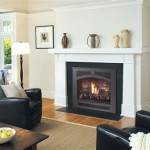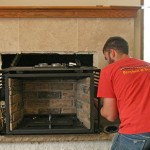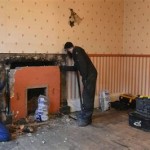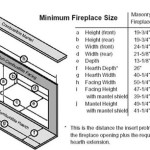```html
Gas Log Fireplace Glass Clean: A Comprehensive Guide
Gas log fireplaces offer the ambiance of a traditional wood-burning fireplace without the associated mess and labor. However, over time, a film or residue can accumulate on the glass doors, diminishing the aesthetic appeal and potentially hindering the viewing experience. This residue typically consists of soot, mineral deposits from the gas itself, and byproducts of combustion. Maintaining the glass doors is crucial for preserving the fireplace's beauty and functionality. This article provides a detailed guide on cleaning gas log fireplace glass, covering preventative measures, cleaning methods, and troubleshooting common issues.
Understanding the Residue on Gas Fireplace Glass
The accumulation of residue on gas fireplace glass is a natural consequence of burning propane or natural gas. While gas burns cleaner than wood, it still produces byproducts that can deposit on the glass surface. The type of residue and its severity can be influenced by several factors, including the type of gas used, the efficiency of the fireplace, and the frequency of use. The following are common components of the residue:
Soot: Incomplete combustion can lead to soot formation. While modern gas fireplaces are designed for efficient burning, factors like improper gas-to-air mixture or malfunctioning components can result in increased soot production.
Mineral Deposits: Natural gas and propane contain trace minerals that, when burned, can leave behind a whitish, powdery deposit on the glass. This is particularly noticeable with hard water minerals that might leach into the gas supply.
Condensation and Residue Binding: Condensation can form on the cool glass surface when the fireplace is first lit. This condensation acts as a binder, allowing soot and mineral deposits to adhere more strongly to the glass.
Understanding the composition of the residue is essential for selecting the appropriate cleaning methods and products. Gentle cleaning agents may suffice for light soot, while more aggressive solutions may be required for stubborn mineral deposits.
Preventative Measures to Minimize Glass Residue
Proactive steps can significantly reduce the buildup of residue on gas fireplace glass, minimizing the need for frequent and intensive cleaning. These preventative measures address the factors that contribute to residue formation and promote cleaner burning.
Annual Fireplace Inspection and Maintenance: Regular inspection by a qualified technician is crucial. The technician can ensure the burner ports are clean and free of obstructions, the gas-to-air mixture is properly adjusted, and all components are functioning optimally. This helps ensure complete combustion, reducing soot production.
Proper Ventilation: Adequate ventilation is essential for efficient combustion. Ensure the fireplace vent and chimney are unobstructed and functioning correctly. Restricted airflow can lead to incomplete combustion and increased soot formation.
Using the Correct Fuel Type: Always use the fuel type specified by the fireplace manufacturer. Using an incorrect fuel type can lead to inefficient burning and the production of excessive residue. Switching between propane and natural gas requires specific adjustments to the fireplace.
Avoid Burning Debris: Never burn any materials other than those recommended by the manufacturer, such as decorative fireplace accents designed for gas fireplaces. Burning paper, wood, or other debris can release harmful chemicals and contribute to residue buildup.
Regularly Clean the Burner Area: Periodically cleaning the burner area, following the manufacturer's instructions, can help prevent the accumulation of dust and debris that can interfere with proper combustion. Use a vacuum cleaner with a brush attachment to remove loose particles.
Cleaning Methods for Gas Fireplace Glass
Several methods can be employed to clean gas fireplace glass, ranging from gentle techniques to more aggressive cleaning solutions. The choice of method depends on the severity of the residue and the type of glass used in the fireplace. Always consult the manufacturer's instructions before using any cleaning product or method.
Method 1: Warm Water and Mild Soap
This is the gentlest method and is suitable for light soot and grime. Mix warm water with a few drops of mild dish soap. Dampen a soft cloth or sponge with the soapy water and gently wipe the glass. Rinse with clean water and dry thoroughly with a clean, dry cloth. Avoid using abrasive cleaners or scrub brushes, as they can scratch the glass.
Method 2: White Vinegar and Water
White vinegar is a natural cleaner that can effectively remove mineral deposits and light soot. Mix equal parts white vinegar and water in a spray bottle. Spray the solution onto the glass and let it sit for a few minutes to loosen the residue. Wipe the glass with a clean cloth or sponge, rinse with clean water, and dry thoroughly.
Method 3: Commercial Gas Fireplace Glass Cleaners
Numerous commercial gas fireplace glass cleaners are available on the market. These cleaners are specifically formulated to remove soot, mineral deposits, and other residues from gas fireplace glass. Always follow the manufacturer's instructions carefully when using these products. Ensure the cleaner is compatible with the type of glass used in your fireplace. Certain cleaners are not safe for tempered glass.
Method 4: Razor Blade Scraping (Use with Extreme Caution)
For particularly stubborn residue, a razor blade scraper can be used with extreme caution. This method should only be used on non-tempered glass and should be approached with extreme care to avoid scratching the glass. Hold the razor blade at a shallow angle and gently scrape the residue off the glass. Use short, overlapping strokes. After scraping, clean the glass with warm water and soap or a commercial glass cleaner to remove any remaining residue.
Important Safety Precautions:
- Always ensure the fireplace is completely cool before cleaning.
- Wear gloves to protect your hands from harsh chemicals.
- Protect the surrounding area from spills or drips.
- Ensure adequate ventilation when using cleaning products.
- Never spray cleaning products directly onto hot surfaces.
Troubleshooting Common Cleaning Issues
Even with the best cleaning methods, certain issues may arise when cleaning gas fireplace glass. Understanding these issues and their solutions can help ensure a successful cleaning process.
Streaking: Streaking can occur when cleaning products are not properly rinsed or dried. To prevent streaking, use clean water to rinse the glass thoroughly after cleaning and dry it with a clean, lint-free cloth. Consider using a squeegee for a streak-free finish.
Smearing: Smearing can occur if the residue is not fully loosened before wiping. Allow the cleaning solution to sit on the glass for a few minutes to loosen the residue before wiping. If smearing persists, try using a more aggressive cleaning solution or a razor blade scraper (with caution).
Scratches: Scratches can occur if abrasive cleaners or scrub brushes are used. Avoid using abrasive materials and always use soft cloths or sponges. If a razor blade scraper is used, exercise extreme caution to avoid scratching the glass.
Clouding: Clouding can occur if the glass is not properly dried or if certain cleaning products are used. Ensure the glass is dried thoroughly with a clean, dry cloth. Avoid using cleaning products that contain ammonia, as they can cause clouding.
Residue Returns Quickly: If residue returns quickly after cleaning, it may indicate an underlying issue with the fireplace, such as improper gas-to-air mixture or a malfunctioning component. Schedule a professional inspection to identify and address the root cause of the problem.
By understanding the nature of gas fireplace glass residue, employing preventative measures, and using appropriate cleaning methods, maintaining clean and clear glass doors becomes a manageable task. Regular maintenance and careful cleaning will ensure the gas log fireplace remains an aesthetically pleasing and functional feature of the home.
```
How To Clean A Gas Log Fireplace Ina Comfort Air

How To Clean Hazy Gas Fireplace Glass Nonprofit Home Inspections

How To Clean The Glass On Your Gas Fireplace

How Do I Clean My Fireplace Glass Center Kc

How To Clean The Glass On Your Gas Fireplace

How To Clean A Fireplace Get It Ready For Winter

Cleaning The Glass On Your Gas Fireplace Chores

Cleaning The Inside Of Gas Fireplace Glass Thrifty Decor Diy And Organizing

How To Clean Gas Fireplace Glass Kozy Heat Fireplaces

Why Is It Important To Get My Gas Fireplace Logs Clean Regularly








